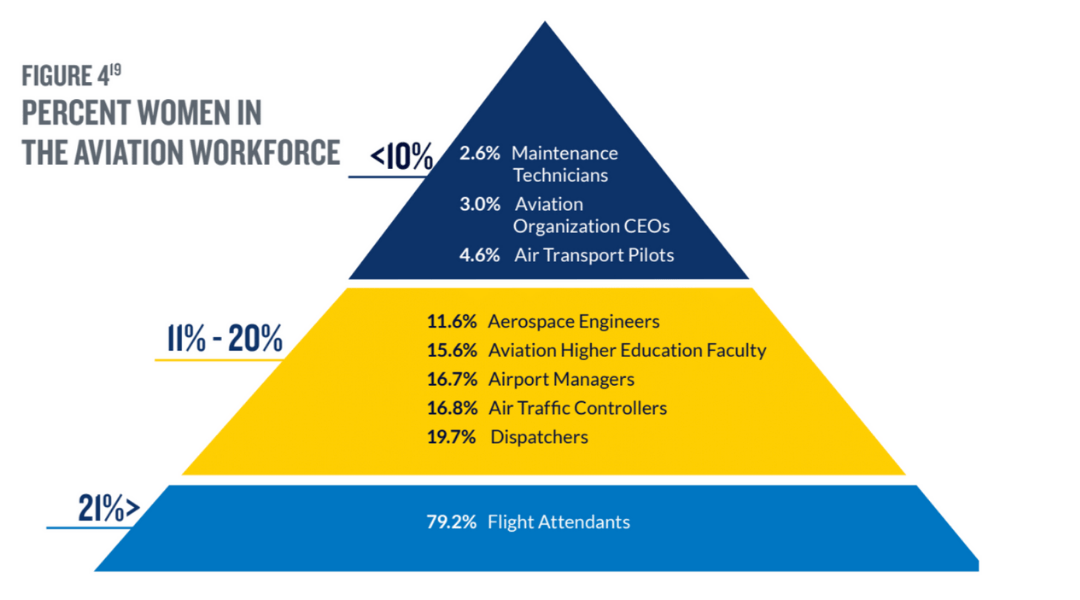Women make up less than 20 percent of the workforce in most aviation occupations in the U.S., a report from the 2022 Women in Aviation Advisory Board shows. Of nine careers in the field, only one, flight attendants, had a preponderance of women. For each of the other eight careers, including airport managers, the percentage of women involved came in below 20 percent.
The report, titled “Breaking Barriers for Women in Aviation: Flight Plan for the Future,” was submitted to the U.S. Secretary of Transportation, the Administrator of the Federal Aviation Administration and the Congress on Wednesday.
The Women in Aviation Advisory Board was created to take a deep look at the industry, identify barriers to recruiting and retaining women, and make recommendations for change. In nearly two years of joint work, the Board reviewed research on the barriers facing women in aviation, identified strategies to address those barriers, and reached consensus on recommendations for change.
“The biggest barrier that discourages women from entering and staying in aviation careers is culture – and it is the hardest to change,” Dr. Heather Wilson, chair of the Women in Aviation Advisory Board and president of the University of Texas at El Paso, wrote in a statement. “Women don’t feel like they belong,” Wilson said. “Changing culture requires consistent leadership commitment over time in thousands of large and small actions across government and industry.”
The report notes that little progress has been made in the 60 years since women entered the aviation industry, and noted that much of the aviation workforce also lacks ethnic and racial diversity. “Women who belong to additional underrepresented groups are part of a very small minority, facing unique barriers and often even greater challenges,” the report said.
The Board recommended a variety of measures aimed at recruiting and retaining women in various fields within aviation, starting outreach and visibility to girls younger than 10 and continuing with girl- and women-centric programs, recruiting and mentoring, as well as gender balance program incentives and family-friendly policies. In general, the Board’s recommendations are grouped into five general areas: culture, recruitment, retention, advancement and data.
Foremost in the recommendations and overarching throughout each stage of an aviation career is culture, the report noted. “Aviation was built around prescribed gender roles that can impact women at every stage of their careers,” it said, and noted challenges with gender bias, discrimination and sexual harassment. The report recommended that Congress and the FAA establish an industry-wide independent reporting program to capture frequency of those incidents, and said leaders in government and industry should proactively foster environments of respect and professionalism.
For recruitment, the report said “early exposure to aviation and ongoing engagement are essential to the recruitment of women into the industry.” It recommended that FAA, in coordination with industry, should develop, maintain and promote a “one-stop-shop” virtual resource center. It also recommended increased federal financial aid and grant programs to recruit women into the industry.
Once in the industry, retention of women is crucial if a more equitable gender balance is to be achieved. “To retain women in aviation, organizations must create environments in which women are seen, heard, and valued,” the report noted, and also pushed for policies that allow women to balance work and life, particularly caregiving responsibilities. Mentoring is also crucial to the retention goal, the report noted.
The goal of advancement is essential to driving cultural change, the report noted, saying that “women in leadership roles must be visible and women must be included in decision making.” The report recommended that industry stakeholders should create professional development programs purposefully designed for women, and the FAA should provide resources and best practices for implementing such programs.
Finally, the report recommends future data collection and research in order to better track progress, noting that current data is lacking on gender statistics in workforce data, pay parity information, women in aviation occupations and leadership, and gender data disaggregated by race/ethnicity.






